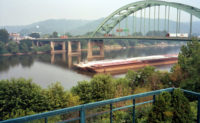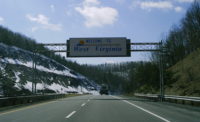Historically, building roads across the Mountain State has proven an arduous task. So when the West Virginia Parkways Authority undertook an ambitious 30-year deck replacement program on the West Virginia Turnpike, it looked for alternative methods to ease the pain. WVPA plans to use accelerated bridge construction (ABC) to replace decks on nearly all of the 116 bridges along the 88-mile turnpike that have been identified for replacement. Using ABC, concrete panel decks are prefabricated off site and then installed within a highly compressed schedule, saving months of onsite construction time when compared with conventional methods.
Jim Meadows, director of maintenance at WVPA, says the authority needed to find a way to replace its bridges without causing significant delays for its toll-paying patrons. The team estimated that using conventional bridge deck replacement construction on each bridge could take between six and eight months, causing significant disruptions.
HNTB estimates that by using precast panels with Accelerated Bridge Construction methods, construction time could be limited to between seven and 12 days.
“We realized when we headed down this road [with the deck replacement program] that this was coming and we’d face shutdowns,” he says. “We had to find a better way.”
The plan to use accelerated bridge construction was recommended by HNTB, which serves as general engineering consultant for WVPA. HNTB estimates that by using precast panels with ABC construction methods, construction time could be limited to between seven and 12 days. Given the short timeframe, construction teams could also schedule construction to avoid peak summer traffic by working after Labor Day and before Memorial Day. Construction could also be sequenced to eliminate shutdowns, allowing one lane of traffic to continue to flow through active construction zones.
That level of convenience comes at a cost. On the first three bridges completed under the program, construction costs ranged from 15% to 20% higher than estimates for conventional methods. But Meadows says that keeping its toll-paying customers happy is worth those extra construction dollars.
“If we have conventional construction going on for months, [a customer] could decide that instead of driving the turnpike, I’ll go another route because I don’t want to pay a toll and sit in traffic,” Meadows says. “Conventional replacement would push construction into the summer, when going down to one lane could mean a 10-mile backup. That’s unacceptable.”
Complete shutdowns also have to be avoided because detours through the twisty local roads of mountainous West Virginia could add hours to a motorist’s drive time. Meadows notes that safety concerns involved with active construction zones could also be mitigated by reducing onsite construction time.
From Planning to Construction Finish
Although onsite construction is limited to under two weeks using ABC, each project can take up to two years to plan, design, bid and construct. Randy Epperly, group director for engineering and vice president at HNTB, says the firm created design standards specific to the program to help create consistency across each project. In keeping with methods used by HNTB on other ABC programs around the country, the project uses prefabricated cast-in-place concrete decks. HNTB designed the panel layouts to maximize repetition in panel dimensions and other specifications when possible. The decks are designed to connect to each other using rapid set concrete closure pours. Shear pockets with stud clusters and grout are used to connect panels to steel girders. Each panel is also cast to include corresponding parapet walls.
WVPA uses a lot of brine in the winter months to pretreat its roads, so it specified applying an asphalt overlay to decks after installation to help reduce exposing the concrete to salt.
Given the need for consistency and quality in panels, WVPA requires all panels to be prefabricated off site. “We felt that in a casting yard there are better controls of materials, construction methods and safety,” Epperly says.
Some panels used on projects so far have been fabricated in facilities that are more than five hours away from jobsites, so Epperly says the panels had to be designed to be easily transported to the site.
Although the bridges follow common design standards, Epperly says the team spends at least six months in design on each bridge. Contractors also need more than six months to prefabricate the panels off site for each project, he adds.
First Use of ABC in W. Virginia
Accelerated bridge construction is still an emerging method and, notably, had not been used in West Virginia before the launch of the deck replacement program. Although it is new, Epperly says the projects are designed in such a way that any qualified contractor could consider using the method. The greatest challenge, he says, is fully understanding the demands of the construction sequence. With schedules compressed from months down to days, tasks are broken down by the hour—sometimes to half an hour.
Work on each side of the four-lane highway is sequenced so that one lane of traffic always remains open while decks on the neighboring lane are replaced.
The goal of the project is speed of delivery, and WVPA has placed much of that risk on its contractors. Construction schedules must be met, regardless of inclement weather or other factors. If delivery dates are not met, contractors face financial penalties.
To avoid traditional requests for information and to expedite resolution of any onsite issue discovered during construction, WVPA assigns professional engineers to be located at the construction site at all times. “Our engineers are out there alongside the workers every minute,” Meadow says. “If it’s an engineering call, they have the liberty to make that call on the spot.”
With its first bridge completed in May 2016, Epperly says the team learned some lessons. It rained during most of the bridge’s construction, making it difficult to add a specified waterproofing membrane. Epperly says the contractor “force dried” the deck to stay on schedule, but that wasn’t sufficient and it resulted in some failures. WVPA will now consider allowing schedule delays during the waterproofing portion of each project on a case-by-case basis. At the suggestion of a contractor, WVPA also changed its specification to call for spray-on waterproofing, which Epperly says is easier to maintain.
HNTB also tested using asphalt plug joints between deck panels on the first bridge in lieu of standard armor joints. Epperly says the team hoped that the asphalt plug design would reduce maintenance needs by keeping water out of the joints between panels. However, he says it did not prove more efficient than armored joints, so WVPA changed the standard.
Half the Onsite Personnel Required
Labor demands offer another significant difference when using ABC methods. Tim Taylor, vice president of the heavy civil division at Brayman Construction, says the company expects to have 50% more personnel onsite during construction of two bridges it will build in September, compared with what would be required on a similar conventional deck replacement project. At a time when there is a construction labor shortage, Taylor says that presents significant challenges.
Brayman is building the two bridges—which are located about a mile apart—at the same time that it is working on another road project nearby. Taylor says a main reason the company bid the job was because it knew it could draw resources from its other road project to help support the WVPA bridges. The panels will also be prefabricated by Brayman Precast, a separate but affiliated company.
Taylor says that the company has done other ABC projects outside of West Virginia, but that it does so on a select basis in part because of the labor demands. “From a corporate perspective, we’re happy to see the use of accelerated bridge construction, but we wouldn’t want to see the industry go 100% in that direction,” he says. “On select projects where we have workforce in the area, we will absolutely bid. But if every job went like that, we wouldn’t have the workforce to handle it. It’s not possible.”
Epperly says the WVPA is taking those issues into consideration as it prepares to let future projects. Where it makes sense, he says WVPA will bundle projects to attract more bidders.
In deciding which bridges it will let out and when, Meadows says WVPA is considering multiple factors, with age and maintenance history the primary drivers. The average age of a bridge on the parkway is 35 years, with the oldest bridge built in 1977 and the newest bridge in 1996. Prior to the program, no decks on those bridges had been replaced. Meadows leads an ongoing bridge inspection and maintenance program that tracks bridge conditions and maintenance costs for each bridge. “We know which bridges cost us the most, so those are the ones we’re targeting first,” he says. “That allows us to move to other bridges, where we do more preventative maintenance.”
Meadows notes that some of the more complex bridges are likely to be let later in the program. That could include several in remote locations with significant changes in elevation on site and other factors that could make prestaging equipment and materials very difficult.
Epperly says the team is also evaluating if only steel structure bridges—which make up the vast majority of its inventory—will be candidates for ABC deck replacements. Some bridges with concrete beams might be considered for the ABC program if the team can assure that the structure won’t be compromised during demolition of existing decks. The parkway also has a few truss bridges, which Epperly says are unlikely to be part of the program. “We don’t see how you could stage the equipment to make that work,” he says.
WVPA is paying for the program entirely with toll revenue. Under the current plan, WVPA has budgeted roughly $15 million annually for the next few years, gradually escalating to more than $30 million annually by 2030. At that rate, Meadows expects the program to average three or four replacements per year. He also notes that, while its bridge decks do need to be replaced, none of them are critically deficient. “We can take advantage of the market,” he says. “If the prices are coming in high, we can pull back [the program] a little bit. If the market is good, we can be more aggressive.”
Regardless of when bridge work is let out and how many end up using ABC methods, Meadows says WVPA already sees the benefits. “Even if only 80% of our redecking is done under this program, that’s still a lot of convenience for our patrons,” he says. “We’d save them a lot of grief.”










